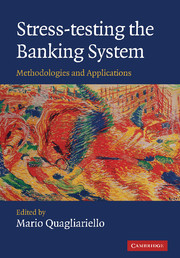Book contents
- Frontmatter
- Contents
- List of figures
- List of tables
- List of boxes
- List of contributors
- Foreword
- Acknowledgements
- Introduction
- Part I Fundamentals
- Part II Applications
- 8 Stress-testing credit risk: the Italian experience
- 9 Stress-testing US banks using economic-value-of-equity (EVE) models
- 10 A framework for integrating different risks: the interaction between credit and interest rate risk
- 11 Stress-testing linkages between banks in the Netherlands
- 12 An integrated approach to stress-testing: the Austrian Systemic Risk Monitor (SRM)
- 13 From macro to micro: the French experience on credit risk stress-testing
- 14 Stress-testing in the EU new member states
- 15 Cross-border macro stress-testing: progress and future challenges for the EU
- 16 Stress-testing at the IMF
- Conclusions
- Index
- References
14 - Stress-testing in the EU new member states
from Part II - Applications
Published online by Cambridge University Press: 18 December 2009
- Frontmatter
- Contents
- List of figures
- List of tables
- List of boxes
- List of contributors
- Foreword
- Acknowledgements
- Introduction
- Part I Fundamentals
- Part II Applications
- 8 Stress-testing credit risk: the Italian experience
- 9 Stress-testing US banks using economic-value-of-equity (EVE) models
- 10 A framework for integrating different risks: the interaction between credit and interest rate risk
- 11 Stress-testing linkages between banks in the Netherlands
- 12 An integrated approach to stress-testing: the Austrian Systemic Risk Monitor (SRM)
- 13 From macro to micro: the French experience on credit risk stress-testing
- 14 Stress-testing in the EU new member states
- 15 Cross-border macro stress-testing: progress and future challenges for the EU
- 16 Stress-testing at the IMF
- Conclusions
- Index
- References
Summary
Introduction
There are several important common features of Central and Eastern Europe (CEE) financial systems that influence the analysis of financial stability, including the design of stress tests. Financial systems in European Union (EU) new member states (NMS) are bank-dominated, making banks the focal point of financial stability analysis. Therefore macro stress-testing rarely includes non-bank financial institutions.
The CEE banking systems have a relatively short history of functioning in a market economy and they went through deep-reaching processes of structural change. These included privatisation, development of local financial markets and a broadening of the product range. Perhaps the biggest changes took place in the ownership structure. Most state-owned banks in the region were privatised and taken over by foreign investors, who introduced their skills and corporate culture, significantly changing the market behaviour of many banks. The picture of banking systems found in historical time series is also influenced by important one-off events. The restructuring programmes in the Czech Republic and Slovakia, after their banking systems experienced problems in the late 1990s, are examples of such structural breaks. These developments mean that time series consistent with the current shape of the financial system are quite short.
As mentioned, NMS banks are typically owned by international banking groups, mostly from EU-15 countries. This influences the policy of NMS banks, making them put more emphasis on local market operations.
- Type
- Chapter
- Information
- Stress-testing the Banking SystemMethodologies and Applications, pp. 261 - 277Publisher: Cambridge University PressPrint publication year: 2009



